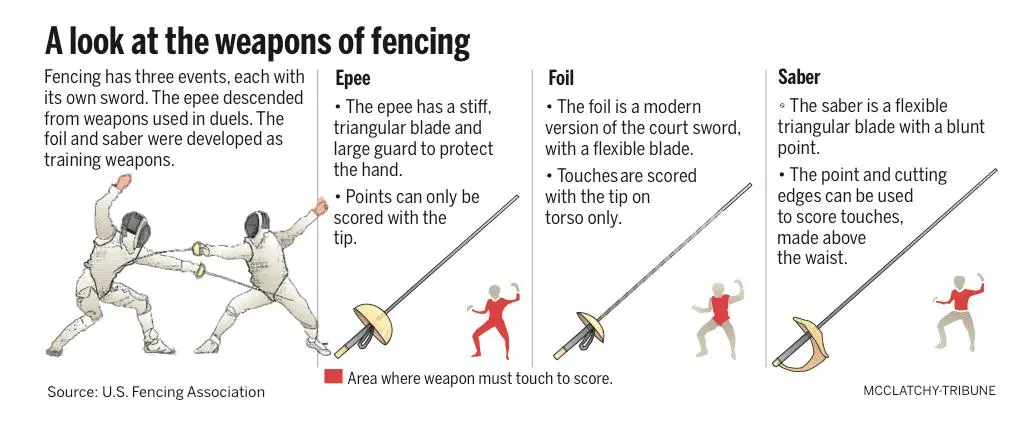Behind the Mask: Corruption in Olympic Sabre Fencing

Fencing is weird and complicated. Suspected cheating at the highest level is making it more so.
You may have tuned into the Olympics this year, or have at least seen a few of the viral moments during the festivities, including Australian breakdancing sensation Raygun or Turkish sharpshooter Yusuf Dikeç for his nonchalant demeanor. Although the games’ popularity has waned throughout the years, some find joy in watching the games for the ceremonies, rooting for their home country, and for some (including myself), spectating odd sports.
I started watching sport fencing during the 2016 Rio de Janeiro Summer Olympics through short videos and highlight reels online. Something about it fascinated me – it was weird. Two people were wearing gear akin to an astronaut suit or a beekeeper’s garb, holding a steel sword with an incredibly thin and bendy blade, and were trying to hit each other. Both combatants have a wire protruding from underneath their jackets, almost tethering them to the playing field, and what followed was something I have never seen before… and I loved it. Through the confusion and bewilderment of what I had just witnessed, I thought to myself, “I think I found my new favorite odd sport.”
As I started to watch more fencing in my own time, I discovered that this incarnation of the sport has been in every modern Olympic competition, starting with the 1896 Games in Athens. Originating in the Byzantine Empire in the late sixth century, fencing evolved into a sport with its introduction to the nineteenth-century military training regimen. Today, modern sport fencing has three disciplines–foil, épée, and sabre–each with its own unique history, techniques, and rules.

For example, not all hits are valid. Épées and foils are thrusting weapons, meaning you can only use the tip of the blade to score. On the contrary, sabres are slashing weapons, allowing you to use the entire length of the blade, making it the most aggressive and fast-paced out of the three. Another distinctive rule of foil and sabre fencing is called right of way, or priority. If two athletes were to successfully hit each other in less than half a second, then it would come down to priority to determine who gets the point (in épée, both players would receive a point). Right of way can be gained through attacking before your opponent, parrying (deflecting) your opponent’s blade, but also lost by missing, hesitating, or being parried. Priority may alternate between players multiple times, or once throughout a round. This may sound confusing because it is–sometimes referees may see and call the same play differently.
Further advancements in technology eventually led to the development of an electronic scoring system, with all disciplines adopting its use by the 1980s. While this breakthrough put less bias and error into scoring, a consequence of its implementation was that fencing got much faster, with hits sometimes occurring milliseconds apart. Emphasis was now being placed on speed rather than traditional form and bladework, which helped it break away from its historical roots and limitations.
1980 Moscow Olympics Highlights
2024 Orléans Sabre Grand Prix Highlights
Despite fencing being scored electronically with specialized equipment, a more accurate description would be to call the scoring electronically-assisted. Referees were very much still required, particularly for foil and sabre. Helping greatly with single touches, when both players made contact within the short timeframe, it would still be left up to the referee’s discretion. With the increase in the speed at which the sport is played, the referee’s input has become even more valuable, with not many safeguards to prevent fraud.
A forty-eight-minute YouTube investigation, titled “Fencing’s Biggest Open Secret” highlighted numerous suspicious incidents in recent memory. The video was uploaded by “ponce de león fencing,” an anonymous former Olympian who is deeply worried about the sport’s future. Although retired from fencing, she remains an avid follower of sabre and has expressed frustration over the lack of decisive action being taken to address these issues.
Vasil Milenchev, a seasoned referee from Bulgaria was accused of giving unfair advantages to fencers from his home country at some of the world’s most prestigious competitions. At the Kuwait Satellite World Cup in 2023, replays reveal Milenchev (a referee in the tournament), coaching a Bulgarian fencer, violating FIE (International Fencing Federation) law.
Milenchev was also suspected of providing preferential treatment to certain fencers, specifically Mitchell Saron from the United States. Saron performed abnormally well while Milenchev reffed his pre-elimination matches, greatly advantaging him to qualify for the 2024 Olympics. Additionally, Saron was assigned to Milenchev an unusually high number of times during tournaments.

“ponce de león” calculates a “Ref Ratio,” defined as the number of unique referees encountered divided by the number of rounds fenced, for six other athletes comparable to Saron’s skill level, averaging around 0.9118. Since this value is close to one, these fencers did not encounter the same referee twice within this tournament. However, Saron had a ratio close to 0.6500, meaning he had been assigned Milenchev much more frequently in the same competition. Mitchell Saron performed more than four times worse anytime Milenchev did not referee him.
Kuwaiti fencer Yousef Alshamlan’s coach, former FIE referee Marco Siesto allegedly colluded with other referees to help Alshamlan make it to the 2020 Olympics. Video footage from the Budapest World Cup in 2021 shows Siesto making comments to the referee before the match begins. Though difficult to hear through the loud music and other background noise, the uploader affirms that the coach implied that Anstett [Alshamlan’s opponent] cannot qualify and should not win. Other shady behavior such as intimidation from Siesto can be seen throughout this match. Despite some dubious calls in Alshamlan’s favor, Anstett would end up victorious.
Aside from more dishonest reffing, “ponce de león” theorizes that Alshamlan has participated in match-fixing to qualify for the 2024 Olympics.
Attention was also placed on Tatiana Nazlymov, a member of the USA women’s sabre team. The Nazlymov fencing dynasty has roots in sabre, with her grandfather, Vladimir, becoming an Olympian in the late sixties and seventies for the USSR. Tatiana’s father, Vitali runs a fencing club in the Bethesda, Maryland area.
But the family’s record has not been clean. Vladimir Nazlymov has been in hot water for recruitment inducement, or swaying athletes to attend a particular institution, leading to his retirement from Ohio State University. Valiyev Fikrat, an Azerbaijani referee, was employed as a mentor at the Nazlymov Fencing Foundation but would go on to referee Tatiana’s matches with less than surprising results. Interestingly, “ponce de león” states that Tatiana performs much better in international competitions, rather than domestic ones, despite the latter being much easier.
It doesn’t end there. Corruption between Vladimir Nazlymov and Valiyev Fikrat was also speculated. In 2019, Nazlymov would become coach of Uzbekistan’s national sabre team, and Fikrat, still employed at Nazlymov Fencing, was under suspicion of giving Uzbek fencers help. “ponce de león” says that “this is not an isolated incident” and “comically bad calls are being made” in favor of Uzbekistan.
Pablo Torre, an investigative journalist, digs deeper into the stories of Mitchell Saron and Tatiana Nazlymov in his video, “Match-Fixing, the Oligarch and the Ivy League: Inside the Most Corrupt Sport at the Olympics”.
Saron’s personal coach, Oleg Stetsiv, is also Nazlymov’s coach. Stestiv also recruited Tatiana to the Princeton University sabre team. Torre also finds a staggering connection: Stestiv and Milenchev have both worked at the Nazlymov Fencing Foundation.
Fencing is not a popular sport, so it is understandable that some of these issues do not have widespread recognition. While relatively unknown to most in the world, for those who compete it means everything.
At the international level, many high level fencers and officials know each other, which has prevented these issues from getting fixed. Unfortunately, when wrongdoing is noticed and accounted for, punishments are not severe enough. USA Fencing tried to prohibit Milenchev from reffing Nazlymov and Saron, to no effect. Bans are rarely handed out.
Footage of these matches are extremely hard to come by as well. For such an “elite” sport that has its roots within the Ivy League, many of these world-class bouts are not recorded. Much of the evidence for this investigation had to be compiled from multiple different sources, many of them hand recorded from fencing enthusiasts.
Another reason is because many are afraid to voice their concerns. Russian-Uzbek oligarch Alisher Usmanov, currently sanctioned by the US, EU, and UK governments, is the four-term President of the International Fencing Federation.

Usmanov not only has relations with Russian President Vladimir Putin, but also International Olympic Committee President Thomas Bach. Usmanov has wielded incredible power over the FIE and the fencing scene and is not afraid to use that power for his own interests. In fact, Alisher Usmanov hand-picked Vladimir Nazlymov to coach the Uzbekistan sabre team.
But some are starting to speak out, including Marcus Schulz, a former sabre referee.
“I will receive threats after this, you can be sure about that. I will get very ugly messages, maybe someone will threaten my family. These things will happen. But I am not afraid… somebody needs to start… maybe more will follow,” Schulz said to Torre in an interview.”
Schulz also believes that half of the world’s top twenty referees are corrupt and the entire system needs to be brought down to be built back up.
Andrew Fishl, who runs the fencing YouTube channel CyrusofChaos has personally attested that three of his elite sabre fencing friends are retiring from the 2024-2025 season until the corruption is addressed and taken care of. Fishl has taken it upon himself to study the cheating pandemic in his own time through surveys and analysis.
While fencing has some pretty dire issues with integrity, it is not the only sport with these issues.
According to the United Nations, corruption in sports is worth $1.7 Trillion annually. Match-fixing, illegal betting, extortion, and doping were the most commonly committed crimes, especially in the sport of soccer, which the UN defined as “the most corrupt sport.”
Further research from INTERPOL–the International Criminal Police Organization–has revealed certain interesting trends. Each National Central Bureau Zone, loosely representing each continent, did not have an equal number of corruption investigations from 2018 to 2023. Europe was the most targeted region with 233 distinct cases, while the Caribbeans and Central America had only 5.
Some governments have promised to fight fraud, like many European Union member countries, with the Macolin Convention being signed into law in 2019. But legislation on the matter is few and far between. Worse yet, data on the topic is rarely made publicly available, which makes it difficult to gauge its effectiveness. Transparency is something that every sports governing body needs to work on in the future.
No matter which sport you may be a fan of, I hope that corruption does not ruin the games that we love so much.
Work Cited:
Fencing-Russians win second consecutive gold in women’s team sabre
Australian breaker Raygun says she felt ‘panic’ after public reaction to her Olympic performance
Shooting-Casual Turkish shooter goes viral, teammate says he earned it
Summer Olympics Poised to Have Record-Low U.S. Viewership
The fascinating history of fencing: From ancient duels to modern sport
Bay Area a fencing incubator that’s ‘exploding’
Sabre Fencing Team Final Olympic Games 1980 Moscow Highlights
Men’s Highlights | Orléans Sabre Grand Prix
Vladimir Nazlymov Olympic Profile
NCAA hits OSU fencing, women’s basketball and women’s golf with 4-year probation
Nazlymov, Vladimir Aliverovich Biography (Translated from Russian)
Match-Fixing, the Oligarch and the Ivy League: Inside the Most Corrupt Sport at the Olympics | PTFO
Treasury Targets Russian Financial Facilitators and Sanctions Evaders Around the World
Alisher Usmanov meets the President Thomas Bach at the International Olympic Committee
Analysis of patterns and trends in competition manipulation in sport global data: 2018–2023
UN: Corruption in Sport Worth $1.7 Trillion Annually
The Convention on the Manipulation of Sports Competitions (the Macolin Convention)